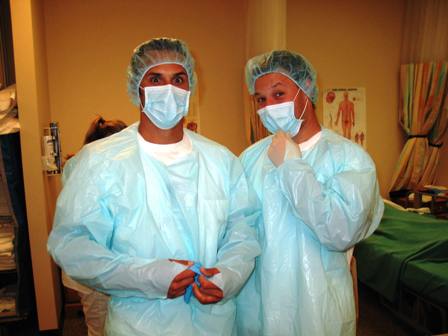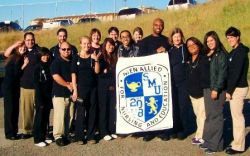Caring About Men Who Care Enough to Pursue Nursing
“If we want to take better care of our nation, we need to reflect our nation.”
It’s a powerful statement expressed by Aara Amidi-Nouri, PhD, RN, Assistant Professor and Director of Diversity at the school of nursing at Samuel Merritt University in Oakland, Calif. Yet when you consider men in nursing, who make up only 6 percent of the workforce, while the US population of males holds strong at 49 percent, it can seem like an elusive ideal.
It hasn’t always been this way. Literature on Indian medical practice in the 5th century BC always portrays nurses as male; Europe in the plague-stricken Middle Ages saw knights and monks risk their lives to care for the sick; and men such as the poet Walt Whitman joined women in large numbers to provide care to wounded soldiers during the American Civil War. These are but a few examples of times when men heard the call of nursing and responded in force.
But at places like Samuel Merritt, the focus is on the future. “We know that the nursing workforce needs to reflect the people we take care of,” says Amidi-Nouri, who also serves as the New Careers in Nursing (NCIN) program liaison at the university. “That includes ethnicity, but it certainly includes gender. We think about the men in nursing and what a small percentage they represent, yet we look at our nation and it’s about half male. We certainly see that we don’t have the representation we need.”
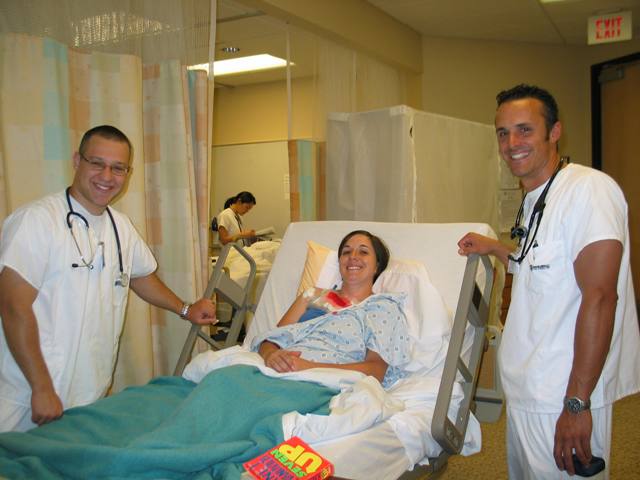 Amidi-Nouri cites the 2008 founding of the campus group Men Allied for Nursing Education (MANE) as making “a huge difference to the men who are here, in terms of their retention and their satisfaction.” MANE also serves as the Bay Area chapter of the American Assembly for Men in Nursing (AAMN), which honored Samuel Merritt with the 2010 award for best nursing school for men (a distinction shared that year with Duke University, the Louisiana State University Health Sciences Center and the University of Pennsylvania). Among other AAMN initiatives is the 20 x 20: Choose Nursing campaign, which seeks to boost male enrollment in nursing programs to 20 percent by 2020.
Amidi-Nouri cites the 2008 founding of the campus group Men Allied for Nursing Education (MANE) as making “a huge difference to the men who are here, in terms of their retention and their satisfaction.” MANE also serves as the Bay Area chapter of the American Assembly for Men in Nursing (AAMN), which honored Samuel Merritt with the 2010 award for best nursing school for men (a distinction shared that year with Duke University, the Louisiana State University Health Sciences Center and the University of Pennsylvania). Among other AAMN initiatives is the 20 x 20: Choose Nursing campaign, which seeks to boost male enrollment in nursing programs to 20 percent by 2020.
More than 400 men have graduated from Samuel Merritt’s nursing program in the past six years, Amidi-Nouri says, and one graduate program, certified registered nurse anesthetist (CRNA), is about 50 percent male. “There has been a lot of leadership by men who’ve come out of that group, and that has been central to our university,” she says. “Our provost, Dr. Scot Foster, was the head of the CRNA program. So we definitely have good role models, in terms of our leadership in nursing. That has set a climate that has attracted men.”
NCIN scholar John Le, RN, BSN, BS, completed his studies in Samuel Merritt’s accelerated degree program in December and serves as an NCIN alumni mentor to five scholars (including one man) who started the program in January.
“I thought about going into nursing a long time ago,” says Le, a former IT professional whose first degree is in biology. “But the common stereotype is that it’s predominantly a female field, and that’s one of the main reasons why I didn’t go into it much sooner.”
Le’s experience reflects what Amidi-Nouri calls “the biggest challenge” for attracting men to nursing: “getting recognition of nursing as a viable profession for men early.”
“Most of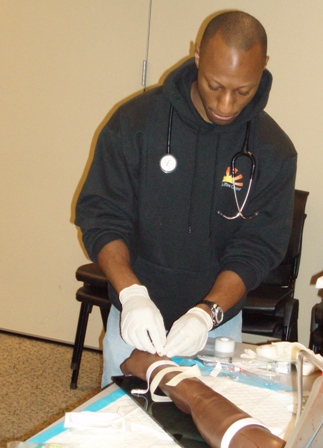 the men here didn’t think they would be nurses in high school,” she says. “They had a different vision for their careers. And that’s true for women as well, but you’ll find a larger proportion of women who thought they were going to be nurses as young as elementary school. It’s important that if we want to grow the percentage of men who go into nursing, we break down some of the images we have of nurses much earlier.
the men here didn’t think they would be nurses in high school,” she says. “They had a different vision for their careers. And that’s true for women as well, but you’ll find a larger proportion of women who thought they were going to be nurses as young as elementary school. It’s important that if we want to grow the percentage of men who go into nursing, we break down some of the images we have of nurses much earlier.
“I do presentations at elementary schools, and I always say, ‘Who’s a nurse?’ And if I show a picture, they always pick the female in white. Those barriers have to be broken down so that people see nursing as a viable option. And the pathway to nursing needs to be clearer—how people go from high school to being a nurse, and what the different pathways are. We do have a lot more men who enroll in second degree programs, and I think we’re attracting more men overall that way than we are through a four-year program right out of high school.”
“Before I started nursing school, I didn’t realize how many opportunities there are for registered nurses,” says Le, who aspires to teach nursing someday. “The field is a lot bigger that I thought it was. If men knew about all the career opportunities there are, that would help draw a lot more of them to the field.”
During his clinical work for his nursing degree, Le expected gender to be a bigger concern than it was. “The only times when I felt that gender was an issue,” he says, “it always had to do with a cultural belief, when members of certain cultures prefer being helped by someone of the same gender. I had some difficulty when we were having our maternity rotation.”
“While male gynecologists are readily accepted, and they deliver babies, and women may not complain, male nurses are not as readily accepted,” Amidi-Nouri says. “Those are definitely barriers that instructors in the clinical setting sometimes have to break down with staff, and explain that this is a nursing student, regardless of their gender, and they’re here for a learning experience. Just like they wouldn’t ask a male medical student to leave, the same thing goes for nursing students.”
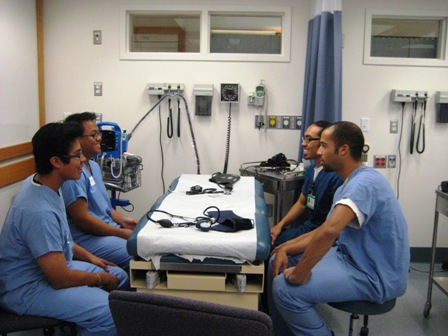
Faculty also need to fight bias in other areas, too, she says. “They need to be aware of their own language in clinical examples they use, especially in case scenarios, case studies and so forth. But also in critiquing the textbooks, materials and articles they use, and bringing gender bias to light, and going out of their way to make sure we bring a balanced perspective to the classroom. We need to do a lot more of that deliberative effort to really start to change our curriculum, to make men feel included. More men are coming into nursing, but we also have to create a very inclusive environment so they feel supported while they are here.”
John Brion, PhD, RN, an assistant professor at Duke University's school of nursing, echoes Amidi-Nouri’s sentiments about the responsibility of faculty. “Using gender-neutral language is a very important thing,” he says. “Faculty typically refer to the nurse as she, so when there’s a he in the class, it reinforces the idea that I don’t belong here. And faculty need to realize that even though men aren’t a minority in the greater society, they are a minority in nursing, and they need to be treated similarly to other minorities. They do have special needs. Part of that is because there is a lack of role models, and a lack of a sense of belonging. Being aware of that and providing the kind of support you’d provide to other minority students is helpful.”
Duke’s AAMN chapter, like Samuel Merritt’s, has also played a role in making male nursing students feel at home at the university. One purpose of the group, says Brion, its faculty adviser, “is to give men a sense of belonging and to help make them more visible here in nursing. When we have activities, we make sure they’re well publicized so that people are aware there are men on campus in the School of Nursing engaging in community service and social activities.”
“One of the things that happens with men,” he says, “and any underrepresented minority, really, is that if they come into a situation where they don’t see similar people, they can experience a lot of stress. It’s an issue called role strain; they don’t know what their role is, and they don’t have anyone to role-model for them. It can be a stressful situation that leads to attrition in programs.”
Despite the challenges that students and faculty face when it comes to men in nursing, Brion knows that they are challenges worth embracing: “The people we care for are diverse in many ways, and one of those is gender diversity, so it helps to have care providers who match the people being cared for. In any situation, the more diversity you have, the more backgrounds, opinions and ideas you can bring to the table.”
